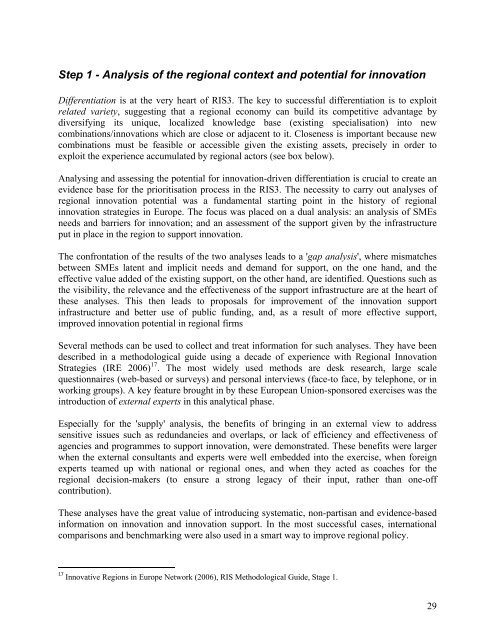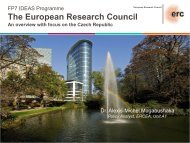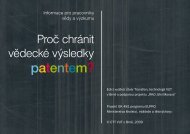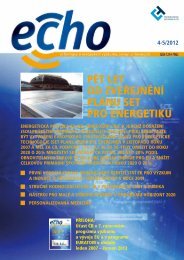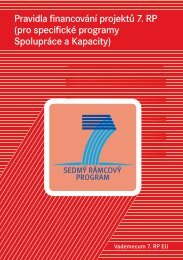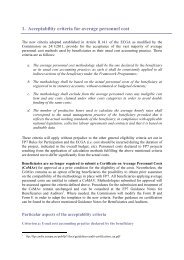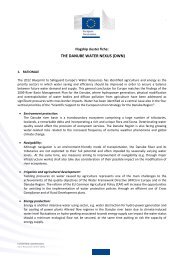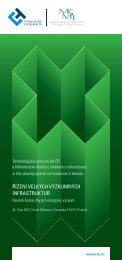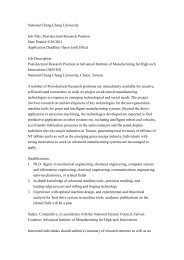Guide to Research and Innovation Strategies for Smart Specialisation
Guide to Research and Innovation Strategies for Smart Specialisation
Guide to Research and Innovation Strategies for Smart Specialisation
Create successful ePaper yourself
Turn your PDF publications into a flip-book with our unique Google optimized e-Paper software.
Step 1 - Analysis of the regional context <strong>and</strong> potential <strong>for</strong> innovation<br />
Differentiation is at the very heart of RIS3. The key <strong>to</strong> successful differentiation is <strong>to</strong> exploit<br />
related variety, suggesting that a regional economy can build its competitive advantage by<br />
diversifying its unique, localized knowledge base (existing specialisation) in<strong>to</strong> new<br />
combinations/innovations which are close or adjacent <strong>to</strong> it. Closeness is important because new<br />
combinations must be feasible or accessible given the existing assets, precisely in order <strong>to</strong><br />
exploit the experience accumulated by regional ac<strong>to</strong>rs (see box below).<br />
Analysing <strong>and</strong> assessing the potential <strong>for</strong> innovation-driven differentiation is crucial <strong>to</strong> create an<br />
evidence base <strong>for</strong> the prioritisation process in the RIS3. The necessity <strong>to</strong> carry out analyses of<br />
regional innovation potential was a fundamental starting point in the his<strong>to</strong>ry of regional<br />
innovation strategies in Europe. The focus was placed on a dual analysis: an analysis of SMEs<br />
needs <strong>and</strong> barriers <strong>for</strong> innovation; <strong>and</strong> an assessment of the support given by the infrastructure<br />
put in place in the region <strong>to</strong> support innovation.<br />
The confrontation of the results of the two analyses leads <strong>to</strong> a 'gap analysis', where mismatches<br />
between SMEs latent <strong>and</strong> implicit needs <strong>and</strong> dem<strong>and</strong> <strong>for</strong> support, on the one h<strong>and</strong>, <strong>and</strong> the<br />
effective value added of the existing support, on the other h<strong>and</strong>, are identified. Questions such as<br />
the visibility, the relevance <strong>and</strong> the effectiveness of the support infrastructure are at the heart of<br />
these analyses. This then leads <strong>to</strong> proposals <strong>for</strong> improvement of the innovation support<br />
infrastructure <strong>and</strong> better use of public funding, <strong>and</strong>, as a result of more effective support,<br />
improved innovation potential in regional firms<br />
Several methods can be used <strong>to</strong> collect <strong>and</strong> treat in<strong>for</strong>mation <strong>for</strong> such analyses. They have been<br />
described in a methodological guide using a decade of experience with Regional <strong>Innovation</strong><br />
<strong>Strategies</strong> (IRE 2006) 17 . The most widely used methods are desk research, large scale<br />
questionnaires (web-based or surveys) <strong>and</strong> personal interviews (face-<strong>to</strong> face, by telephone, or in<br />
working groups). A key feature brought in by these European Union-sponsored exercises was the<br />
introduction of external experts in this analytical phase.<br />
Especially <strong>for</strong> the 'supply' analysis, the benefits of bringing in an external view <strong>to</strong> address<br />
sensitive issues such as redundancies <strong>and</strong> overlaps, or lack of efficiency <strong>and</strong> effectiveness of<br />
agencies <strong>and</strong> programmes <strong>to</strong> support innovation, were demonstrated. These benefits were larger<br />
when the external consultants <strong>and</strong> experts were well embedded in<strong>to</strong> the exercise, when <strong>for</strong>eign<br />
experts teamed up with national or regional ones, <strong>and</strong> when they acted as coaches <strong>for</strong> the<br />
regional decision-makers (<strong>to</strong> ensure a strong legacy of their input, rather than one-off<br />
contribution).<br />
These analyses have the great value of introducing systematic, non-partisan <strong>and</strong> evidence-based<br />
in<strong>for</strong>mation on innovation <strong>and</strong> innovation support. In the most successful cases, international<br />
comparisons <strong>and</strong> benchmarking were also used in a smart way <strong>to</strong> improve regional policy.<br />
17 Innovative Regions in Europe Network (2006), RIS Methodological <strong>Guide</strong>, Stage 1.<br />
29


